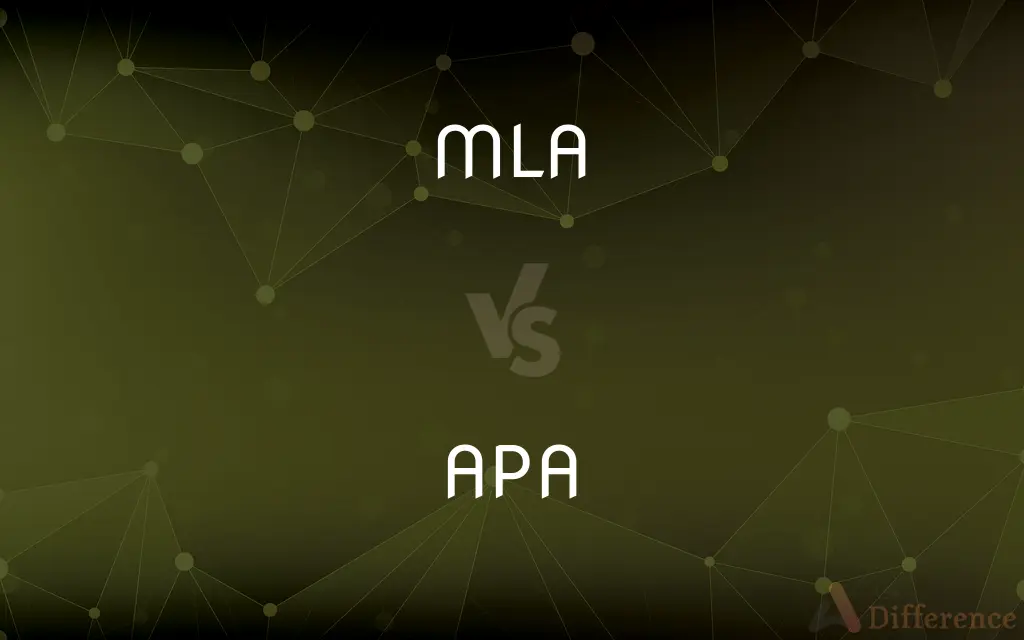MLA vs. APA — What's the Difference?
By Tayyaba Rehman — Published on December 19, 2023
MLA (Modern Language Association) and APA (American Psychological Association) are distinct citation styles used in academic writing; MLA is commonly used in humanities, while APA is typical for social sciences.

Difference Between MLA and APA
Table of Contents
ADVERTISEMENT
Key Differences
MLA and APA are both standardized styles used for citing sources in academic papers. However, they cater to different academic disciplines and, thus, have varied formatting guidelines.
MLA, standing for Modern Language Association, is primarily employed in the humanities, encompassing subjects like literature, arts, and languages. On the other hand, APA, short for American Psychological Association, is a go-to style for the social sciences, including fields such as psychology, sociology, and education.
In terms of formatting, MLA traditionally focuses on the author and the page number when making in-text citations. APA, conversely, emphasizes the author, the publication year, and sometimes the page number, providing a broader context for the source.
For the bibliography, MLA uses the term "Works Cited" to list out the sources at the end of the paper. APA, in contrast, uses "References" to catalog the used sources.
To encapsulate, while both MLA and APA serve the purpose of providing authenticity to academic works by standardizing citations, they have distinct guidelines catering to different academic domains with varying emphasis on source details.
ADVERTISEMENT
Comparison Chart
Primary Use
Humanities (e.g., literature, arts)
Social Sciences (e.g., psychology, sociology)
In-text Citation
Focuses on author and page number
Emphasizes author, publication year, and sometimes page number
Bibliography Title
"Works Cited"
"References"
Publisher Citation
City of publication is included
City is omitted, but DOI or URL is often required
Author Name Presentation
Full name is used
Only last name and initials are used
Compare with Definitions
MLA
A citation style commonly used in the humanities.
For her literature class, she was asked to use MLA formatting.
APA
Emphasizes author, year, and sometimes page number in citations.
Using APA, he cited the study by its author and publication year.
MLA
Prioritizes author and page number for in-text citations.
Following MLA, she cited the quote with the author's last name and page number.
APA
Represents the American Psychological Association.
The APA manual is comprehensive, detailing how to format and cite research papers.
MLA
Uses "Works Cited" for the bibliography.
At the end of her essay, she added a Works Cited page.
APA
Uses "References" for its list of sources.
He made sure to include a References section in his thesis.
MLA
Stands for the Modern Language Association.
The MLA handbook provides extensive guidelines on academic writing.
APA
A citation format predominantly used in the social sciences.
His psychology research paper required APA citation style.
MLA
Includes the city of publication in citations.
In accordance with MLA, she mentioned the city where the book was published.
APA
Often requires the DOI or URL instead of the city of publication.
He added the article's DOI as per APA guidelines.
APA
A title used for male clergy or saints in the Coptic Church.
Common Curiosities
Which disciplines typically use MLA?
Humanities disciplines, such as literature and arts, typically use MLA.
What do MLA and APA stand for?
MLA stands for Modern Language Association, while APA stands for American Psychological Association.
What titles do they use for bibliographies?
MLA uses "Works Cited," and APA uses "References."
How do in-text citations differ between MLA and APA?
MLA emphasizes author and page number, while APA focuses on author, publication year, and sometimes page number.
Which style requires the city of publication?
MLA includes the city of publication, whereas APA often omits it.
Where can I find official guidelines for each style?
The official handbooks or manuals for MLA and APA provide detailed guidelines.
Which style is easier to use?
Ease is subjective; familiarity and discipline requirements often dictate preference.
Is APA exclusive to psychology?
No, APA is used broadly in the social sciences, including sociology, education, and more.
How do they treat the author's name in citations?
MLA uses the full name, while APA uses the last name and initials.
Are there other popular citation styles besides MLA and APA?
Yes, other styles like Chicago and Turabian are also commonly used, depending on the discipline.
Is the DOI necessary in APA?
APA often requires the DOI or URL, especially for online sources.
Can I use both styles in one paper?
Typically, academic papers adhere to one style, as prescribed by the institution or journal.
Why is it important to use standardized citation styles?
Standardized styles ensure consistency, authenticity, and proper acknowledgment of sources in academic writing.
Are there online tools to help with these citation styles?
Yes, various online tools and software can assist in generating MLA and APA citations.
Are these citation styles static?
No, they evolve. Both MLA and APA have seen multiple editions with updated guidelines.
Share Your Discovery

Previous Comparison
Estan vs. Son
Next Comparison
Pets Animals vs. Domestic AnimalsAuthor Spotlight
Written by
Tayyaba RehmanTayyaba Rehman is a distinguished writer, currently serving as a primary contributor to askdifference.com. As a researcher in semantics and etymology, Tayyaba's passion for the complexity of languages and their distinctions has found a perfect home on the platform. Tayyaba delves into the intricacies of language, distinguishing between commonly confused words and phrases, thereby providing clarity for readers worldwide.














































